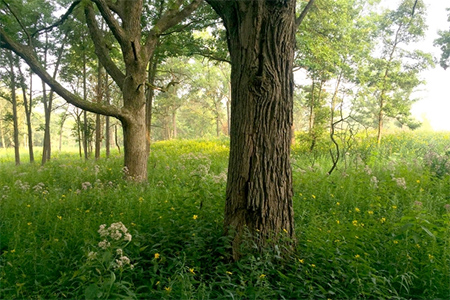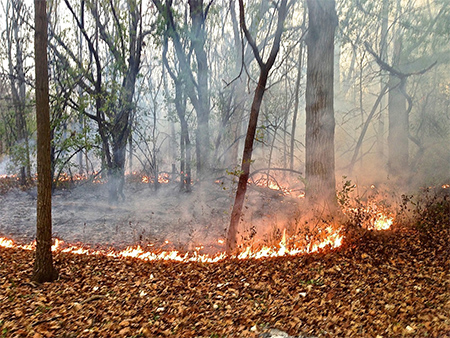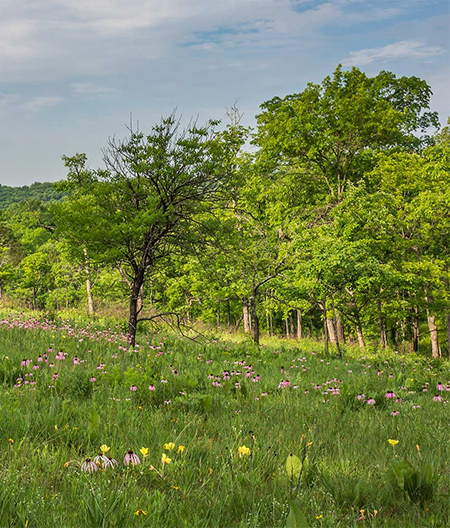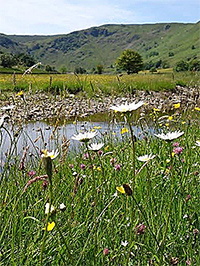Native Plant Conservation Campaign News: Native plant community restoration succeeds with hard work, collaboration, research and community  science.
science.
 science.
science.December 8, 2020
We offer two success stories (plus a bonus) to cheer up the holiday season and to inspire us in the new year.
In Cook County Illinois, researchers have documented impressive results of restoration of a seven-acre ancient oak woodland called the Vestal Grove. This pioneering project was initiated nearly four decades ago by the Forest Preserves of Cook County in cooperation with ecologists at the University of Illinois and others. Their goal was to “to restore, restock, protect and preserve the natural forests and such lands together with their flora and fauna, as nearly as may be, in their natural state and condition.” They have now declared the project a success in a journal article and other publications.
This success required a great deal of work. At the beginning of the project, Vestal Grove was choked with invasive plants and its ecological balance was damaged by fire exclusion and deer over browsing. To address these problems, scientists, land managers and volunteers have spent decades pulling invasive plants; thinning the ancient oaks, harvesting native seed and hand-planting plants; reducing deer populations, and returning fire to the landscape by burning every two years. Native seed was sometimes found in cemeteries, along railroad tracks, and in unused areas of farms.

The result is a “dramatic” restoration of this ancient oak woodland, according to an October study published in the journal PLOS ONE. It is a success story that researchers say holds key lessons for ecological restoration at a time when native plant community restoration is increasingly seen as a critical tool for fighting climate change.
To assess the project’s progress, scientists at the University of Illinois at Urbana-Champaign used the Floristic Quality Index, and other methods of to measure the “native vegetation quality” of the Vestal Grove after 34 years. Indices of ecological integrity all “increased dramatically over time, such that their values now surpass those of the highest quality representative of this habitat in the region.”
Because the surrounding habitat is so altered that it cannot sustain plant community health without human intervention, active management of the area will be required, perhaps in perpetuity.
In Missouri, a similar project is also yielding impressive results. The Missouri Botanical Garden’s 2,400 acre Shaw Nature Reserve offers a snapshot of the plant communities of the Ozark region, according to an interview with Reserve managers published by NPCC Affiliate the Center for Plant Conservation in November.
Shaw Reserve started as badly degraded farmland in the beginning of the last century. The Resereve is now a healthy, diverse microcosm of the Ozark  region’s plant communities, including woodlands, wetlands, savanna, dolomite glades, floodplain forest, and a stretch of the Meramec River. This variety provides valuable opportunities to experiment with rare plant reintroductions and other conservation methods,
region’s plant communities, including woodlands, wetlands, savanna, dolomite glades, floodplain forest, and a stretch of the Meramec River. This variety provides valuable opportunities to experiment with rare plant reintroductions and other conservation methods,
 region’s plant communities, including woodlands, wetlands, savanna, dolomite glades, floodplain forest, and a stretch of the Meramec River. This variety provides valuable opportunities to experiment with rare plant reintroductions and other conservation methods,
region’s plant communities, including woodlands, wetlands, savanna, dolomite glades, floodplain forest, and a stretch of the Meramec River. This variety provides valuable opportunities to experiment with rare plant reintroductions and other conservation methods,Most of the habitats represent pre-conquest native plant communities, but some areas of the preserve were so degraded that researchers also established some post-settlement communities for research and educational purposes.
The Shaw Reserve offers 17 miles of hiking trails, an interactive outdoor classroom space, outreach programs, and the Whitmire Wildflower Garden, a flagship for native plant horticulture in the Midwestern US.
Like the Cook County project, the Shaw Reserve requires labor intensive ongoing maintenance. These initiatives may be time consuming but scientists can be recruited to do research and maintenance; community volunteers can take advantage opportunities to get out into native landscapes and learn about restoration; and school children can combine learning with land management.

Finally, if you enjoy restoration and success stories, we offer delightful bonus from the UK. A consortium of agencies, scientists and volunteers are “rewildling” a Lake District stream to restore the landscape for people, wildflowers, wildlife, farmers, and to improve water quality and supply. The project is part of the “Rewilding Britain” program. The article on the project includes a lovely video.
We hope you enjoy these inspiring stories of native plant community restoration and of all the benefits and services that go along with it.
Photos: Prescribed Fire; Trees, Wildflowers at Vestal Grove © Forest Preserves of Cook County; Shaw Nature Preserve © Missouri Botanical Garden; Lake District © Rewilding Britain